Today we are thrilled to share this bonus post by Katie AKA MissGoggins on Ravelry. Katie saw our Ravelry discussion about posts for WOVEMBER 2015 and suggested that it would be awesome to have a piece about West Yorkshire Spinners. We heartily agreed! In the activist DIY spirit of WOVEMBER, Katie set up an interview and tour date with the mill herself and has returned with this magnificent article for your woolly reading pleasure. Thank you so much Katie and all at WYS for putting another key element of the British Wool Industry on the WOVEMBER map.

In August this year, I made my first trip to the West Yorkshire Spinners (WYS) factory. I live in Bradford and WYS is fairly local to me – just twenty minutes up the road. I went with the intent to buy yarn (and succeeded) and, in the process, was delighted by a brisk walk through the operating factory, full of noisy machinery and fantastic woolly fumes. A new topic on the Wovember forum on Ravelry coincided with this visit; TEAM WOVEMBER were asking what wool enthusiasts wanted to see covered in the blog during Wovember 2015 and I suggested WYS. This resulted in my second visit to WYS headquarters during Wovember to find out a bit about the company and their yarn manufacturing processes.
WYS is based within Keighley, a West Yorkshire town, which during the 18th and 19th Century prospered through the woollen and cotton industry – although today this has virtually gone. Evidence of the industry still remains within the town, with old wool and textile mills and towering chimneys ever-present. These are now largely used by other industries, or as offices and residential properties. WYS is located to the north of the town, with the River Aire located close-by, beyond which lie hills of pasture fields overlooking the factory; to up the romance stakes I’d like to note that a number of these fields are grazed by sheep.
WYS formed in 1997 and the factory was originally based in Oxenhope, a small village outside Keighley in a traditional woollen mill. Increasing demand for their products resulted in relocating the company twice and they now reside in a modern industrial unit. This has allowed for a re-organisations of the plant, new machinery to be purchased and WYS becoming one of the most efficient producers in its field. Although producing on a much larger scale than many of the small producers covered during Wovember, a lot of their ideals remain the same. WYS have a strong desire to promote British wool and to support the chain involved in creating the finished ball of yarn – from farming to dyeing – with most of these processes being carried out within a 40 mile radius. This is all done whilst maintaining a traditional industry and keeping a skill-set with deep-roots within the local area.
On my second visit to the factory I was warmly welcomed to the factory by Peter Longbottom, the managing director of WYS, Richard Longbottom, the sales and marketing manager (and son of Peter) and Emma Ross, the marketing executive. We chatted in the meeting room located above the working factory, which is unlike your usual corporate meeting room; apart from the muted noise of the factory machinery, the room is home to two model sheep taking residence on an artificial lawn in the corner; shelves chocked with tantalising yarn line the walls; and woollen socks in the popular Country Birds colours festoon the office window, strung-up like bunting. This cheerful meeting room speaks volumes about the pride and belief Peter and Richard have in their products, but it makes for a difficult time of it for me, who would just like to be left alone to have a moment with the wool (you know, to throw it in the air money style, make wool angels, etc.) However, with a kindly offered obligatory cup of tea in hand I press on with finding out about the company’s history and future plans. You owe me, guys.

Peter – the company’s managing director – is well-versed in the art of industrial yarn spinning. From leaving school he started out at Hayfield and Sirdar in Glusburn, West Yorkshire where he worked until the mill closed in 1995. WYS were then formed in 1997 and commission spun for other businesses, producing yarn for hand and machine knitting. Around 3 years ago, WYS decided to throw their hats into the ring and launch their own brand of hand knitting yarns. Creating the WYS brand has brought a lot of satisfaction to the team, allowing them control of all the development stages and to work with natural fibres, which Peter affirms to be his great joy. When starting the WYS brand, Peter persuaded Richard – his son, who at the time was working in an advertising agency in London – to leave the glitz and glamour of the big smoke and return to Yorkshire to join the company. To gain background knowledge of an industry of which he had little experience, having a degree in marketing and advertising, Richard returned to university in Huddersfield to take a textile technician access degree; this he admits proved more difficult than his original degree and he had to often resort, at 30, to asking his dad for help with his homework! Peter continues in assisting Richard to gain further experience in the process of producing yarn. They make visits to Haworth Scouring Company in Bradford – where the fibre WYS source is scoured – and to ITMA (a textile machinery trade show) held recently in Milan to view the most advanced equipment in the production of yarn.
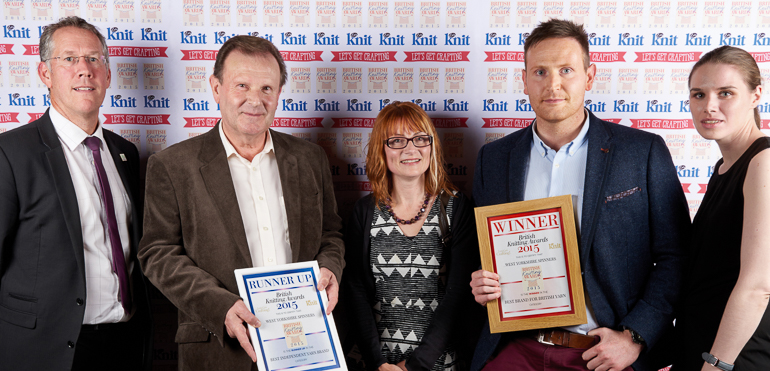
With Richard and Emma Ross – the marketing executive – on board, WYS continue to develop their range, which started with hanked-up Bluefaced Leicester yarn. The range is growing at a rapid rate, which Richard believes is down to customers becoming more discerning in their buying habits and wanting to know where the product comes from and the miles it has travelled to be produced. As previously mentioned, most of the yarn produced by WYS is undertaken within a 40 mile radius, with wool sourced from Curtis Wool based in Bingley, who buy from the British Wool Marketing Board in Bradford. This is then scoured in Haworth Scouring Company in Bradford, and brought to the WYS factory to be blended, prepared, spun and twisted. Dyeing then largely occurs within the UK, with their Country Birds yarn taking place two minutes down the road and being printed by WYS themselves.

Peter, Richard and Emma also put the company’s success down to the power of social media, with knitters sharing their finished objects and their love of the WYS products online. Richard admits that if he’s having a stressful day this is often remedied with a visit to Instagram or Ravelry to see what the knitting community is doing with his yarn and he is continually blown-away by the far-flung locations of where the yarn lands. WYS also benefit from social media by being able to promote their products on their own social media pages; a recent example of this was prior to launching three new County Birds shades in the Signature 4-ply base, they encouraged customers to enter a ‘Name that Bird’ competition, asking to match the shades of the yarn to the bird which was the inspiration. They got a lot of response from this competition and also courted a surprising amount of controversy, with one of the shades being inspired by the non-native Peacock (gasp!). Although controversial, the Peacock shade is proving very popular and Emma quips that it is literally flying out the doors (pun definitely intended).
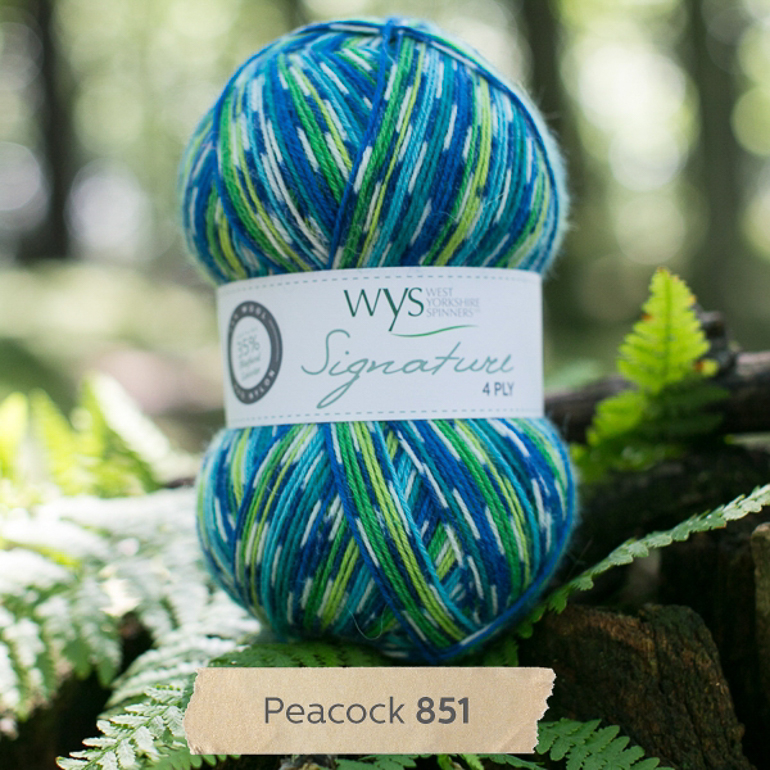
In addition to the mix of fun, controversy and stress relief provided by social media, having an online presence allows WYS to have a close relationship with their customers, which helps in furthering the development of their range. Richard commented that in the last 8 months they have seen an increase in the popularity of their single breeds yarns, with the company’s range also including un-dyed Wensleydale and Jacobs yarns. Due to this increased interest, Peter informs that new breed-specific yarns are currently being developed and tested as potential products within the WYS range for the future.
After a fascinating chat, Peter, Richard and Emma took me on a tour of the operating factory. I was surprised at the team’s enthusiasm for hosting such tours, with Richard mentioning that they have recently shown a group of thirty Women’s Institute (WI) members round the factory, but they are genuinely thrilled to promote what they’re doing. Peter’s enthusiasm for the machinery on site is infectious. Firstly I was shown the machine involved in blending the wool, which at the time of the tour was blending natural white wool with 15% dyed black wool in order to obtain a beautiful pale grey shade.
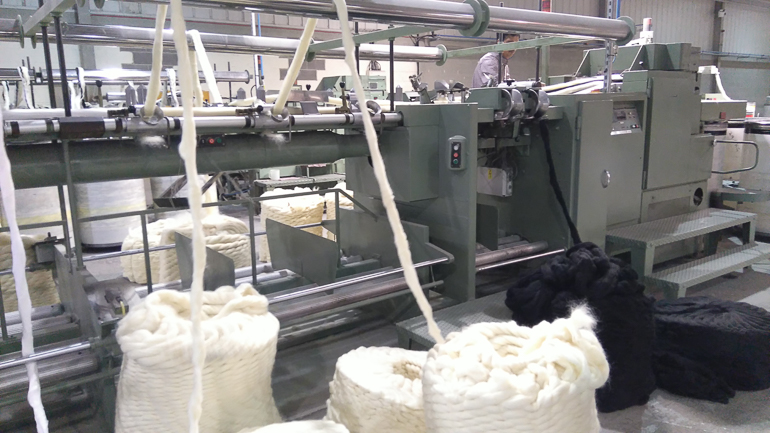
This blended wool was then sent through a number of machines, all of which were combing the wool. Combs used become progressively finer to make the fibres lie parallel; to remove short or irregular fibres; and to reduce the thickness of the material until it becomes a suitable diameter for spinning. This is how worsted-spun yarn is produced and it’s through this process that WYS yarns are predominantly spun. Blended and combed tops are deposited and stored in cans, each of which holds up to 40 kilos of fibre that will take one week to be spun.
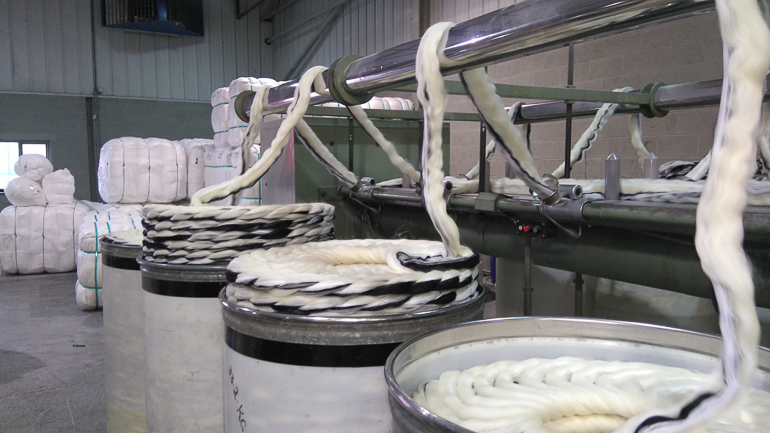

The spinning machines in the WYS factory have a total of 400 spindles, and with the factory operating a double-shift system this allows 15,000 kilos of yarn to be spun in a week.

Once spun as a single ply, the spun fibre is transferred to an automatic winding machine (which Peter assures me is a very expensive piece of kit!) As the fibre is being wound, it passes through an electric yarn clearer which measures the cross sectional area of the yarn and detects any faults (thick/thin sections, any imperfections, etc.) A computer is set with what the cross-sectional area should measure and if the spun fibre deviates from this it is cut. Peter demonstrates a fault, by inserting a £10 note into the yarn clearer and the fibre is immediately cut. The machine then finds the cut end of the fibre, removes the fault and joins the fibre back together with compressed air. Pretty impressive stuff. The spun fibre is then plied on an assembly winder. Once the tour of this factory is complete Peter informs me that with these modern processes they can boast few imperfections in the wool they produce, such as knots, which Peter refers to as taboo in the production of hand-knitting yarns!
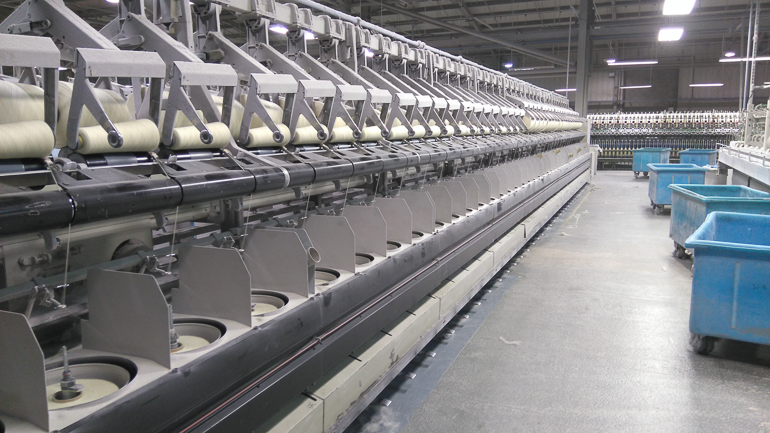
The efficiency in which WYS can produce yarn has allowed the company to become an exporter of yarn produced from British wool, with approximately 600,000 kilos of yarn spun on commission and exported to Scandinavia annually. In my opinion this is a contrast to a number of other British yarn companies who predominantly import their yarn from countries such as Turkey and China and it’s encouraging to think that a major player in the spinning industry remains faithful to, and is inspired by, British wool and the qualities it possesses. The export of yarn spun at the WYS factory is a major part of their business and allows them to invest in their own brand and its development. One such investment is a factory building housing the printing side of the process, allowing them to produce the County Birds shades. The factory is located two minutes down the road from where the spinning takes place and this is the final stop of the tour. Here, machines carry out the printing, which can involve up to six different shades and which is controlled by a computer set to produce different sequences of stripes, dots, etc. I am also introduced to Sarah who works as a dyeing technician and whose hands – being coloured a vibrant shade of pink – are testament to that fact. A lab is located to the corner of the factory and here the printed yarns are tested, with a large box of knitted-up swatches allowing decisions to be made as to which colours, sequences, etc. work and which configurations do not.
In conclusion to my tour, it is clear that the WYS team are enthusiastic in continuing to develop their range and maintain this once major industry within the Bradford area, with the desire to bring young people through in order to keep it alive. As Emma puts it, they are working in a traditional industry that’s been rejuvenated through the innovation of modern processes. Long may this continue.
Thank you greatly to the WYS team for welcoming me so warmly to the factory and for the fascinating tour.
Huge thanks to Katie and all at WYS for this wondrous feature, and for enabling WOVEMBER to continue a little longer…